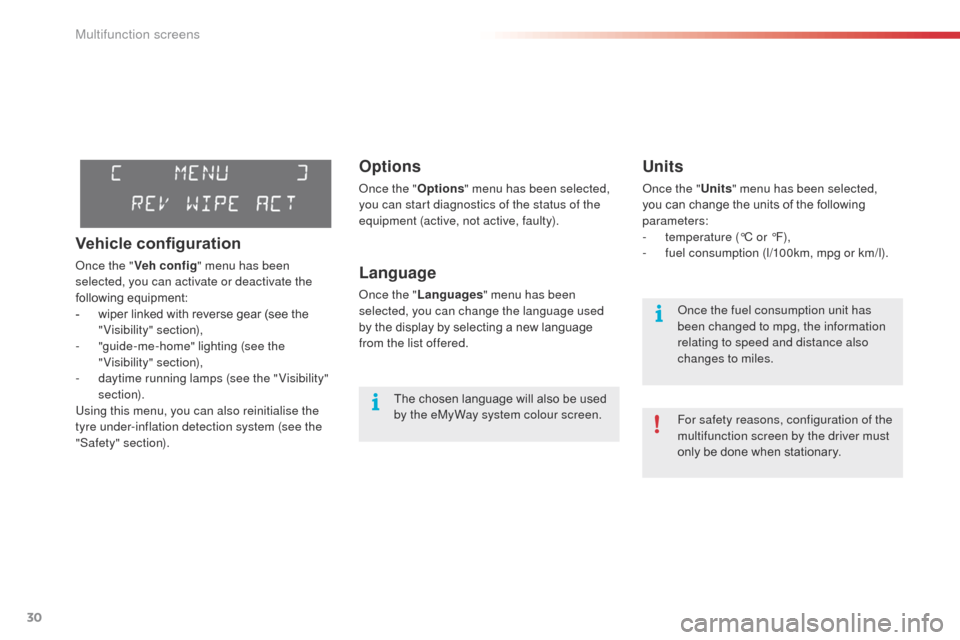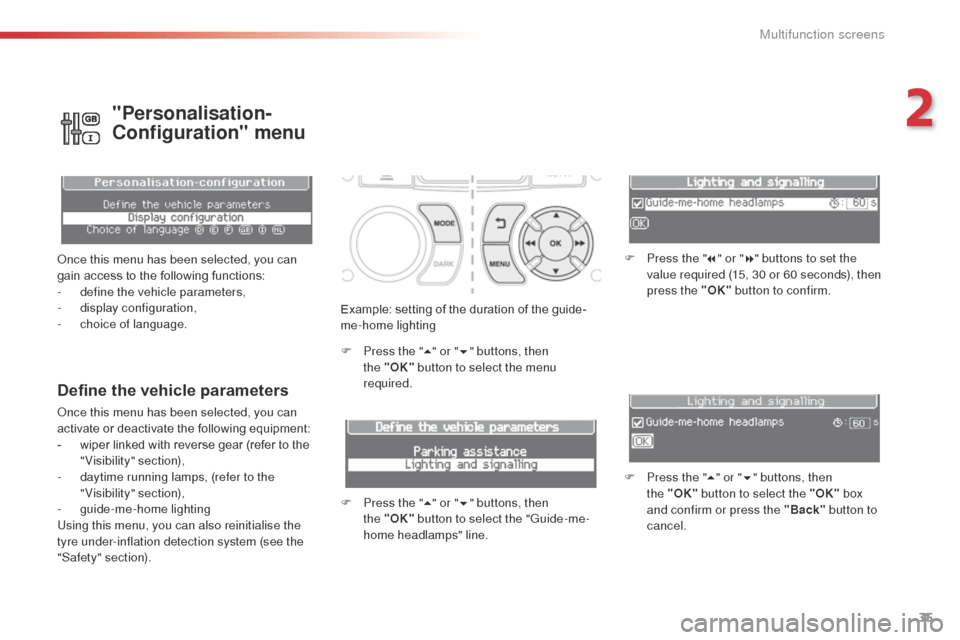2014 Citroen C3 PICASSO run flat
[x] Cancel search: run flatPage 5 of 292

.
.
C3Picasso_en_Chap00a_sommaire_ed01-2014
direction indicators 107
Hazard warning lamps
1
07
Horn
108
Emergency or assistance call
1
08
Tyre under-inflation detection
1
09
br
aking assistance systems
1
13
Trajectory control systems
1
14
Front seat belts
1
15
air
bags
119
Safety
Parking brake 1 23
6 -speed manual gearbox
1
23
6 -speed electronic gearbox system
1
24
Gear shift indicator
1
28
Hill start assist
1
29
Stop & Start
1
30
Speed limiter
1
33
Cruise control
1
35
Rear parking sensors
1
37
Reversing camera
1
39
driving
Emergency or assistance 199
eMyWay
2
01
au
dio system
2
55
audio and telematics
Alphabetical index Visual search
bon n e t 1
41
Running out of fuel (
di
esel)
1
42
Petrol engines
1
43
di
esel engines
1
44
Checking levels
1
45
Checks
14
8
Checks
Temporary puncture repair kit 150
Changing a wheel
1
55
Snow chains
1
62
Changing a bulb
1
63
Changing a fuse
1
72
bat
tery
179
Energy economy mode
1
82
Changing a wiper blade
1
83
Towing the vehicle
1
84
Towing a trailer
1
86
Fitting roof bars
1
87
ac
cessories
188
Practical information Technical data
Petrol engines 1
90
Petrol weights
1
91
LPG engines
1
92
LPG weights
1
93
di
esel engines
1
94
Diesel weights
1
95
di
mensions
196
Identification markings
1
97
Contents
Page 32 of 292

30
C3Picasso_en_Chap02_ecran-multifonction_ed01-2014
Options
once the "Options" menu has been selected,
you can start diagnostics of the status of the
equipment (active, not active, faulty).
Language
once the " Languages " menu has been
selected, you can change the language used
by the display by selecting a new language
from the list offered.
Units
once the " Units" menu has been selected,
you can change the units of the following
parameters:
-
t
emperature (°C or °F),
-
f
uel consumption (l/100km, mpg or km/l).
The chosen language will also be used
by the eMyWay system colour screen. For safety reasons, configuration of the
multifunction screen by the driver must
only be done when stationary.
on
ce the fuel consumption unit has
been changed to mpg, the information
relating to speed and distance also
changes to miles.
Vehicle configuration
once the " Veh conf ig " menu has been
selected, you can activate or deactivate the
following equipment:
-
w
iper linked with reverse gear (see the
"Visibility" section),
-
"
guide-me-home" lighting (see the
"Visibility" section),
-
d
aytime running lamps (see the " Visibility"
section).
Using this menu, you can also reinitialise the
tyre under-inflation detection system (see the
"Safety" section).
Multifunction screens
Page 37 of 292

35
C3Picasso_en_Chap02_ecran-multifonction_ed01-2014
Example: setting of the duration of the guide-
me-home lighting
F
P
ress the " 5" or " 6" buttons, then
the
"OK" button to select the menu
required.
F
P
ress the " 5" or " 6" buttons, then
the
"OK" button to select the "Guide-me-
home headlamps" line. F
P
ress the "
7" or " 8" buttons to set the
value required (15, 30 or 60 seconds), then
press the "OK" button to confirm.
F
P
ress the "5" or " 6" buttons, then
the
"OK" button to select the "OK" box
and confirm or press the "Back" button to
cancel.
Define the vehicle parameters
once this menu has been selected, you can
activate or deactivate the following equipment:
-
w
iper linked with reverse gear (refer to the
"Visibility" section),
-
d
aytime running lamps, (refer to the
"Visibility" section),
-
gu
ide-me-home lighting
Using this menu, you can also reinitialise the
tyre under-inflation detection system (see the
"Safety" section).
"Personalisation-
Configuration" menu
once this menu has been selected, you can
gain access to the following functions:
-
d
efine the vehicle parameters,
-
d
isplay configuration,
-
c
hoice of language.
2
Multifunction screens
Page 164 of 292

162
C3Picasso_en_Chap11_informations-pratiques_ed01-2014
Snow chains
original tyre sizeMaximum link size.
195 / 60 R15 9 mm
195 / 55 R16 9 mm
205 / 45 R17 7 mm
For more information on snow chains,
contact a CITR
oËn
dealer or a
qualified workshop.
In wintry conditions, snow chains improve traction as well as the behaviour of the vehicle when
braking.
The snow chains must be fitted only
to the front wheels. They must never
be fitted to "space-saver" type spare
wheels.
Take account of the legislation in force
in your country on the use of snow
chains and the maximum running speed
authorised.
Advice on installation
F If you have to fit the chains during a journey, stop the vehicle on a flat sur face
on the side of the road.
F
a
p
ply the parking brake and position any
wheel chocks to prevent movement of your
vehicle.
F
F
it the chains following the instructions
provided by the manufacturer.
F
M
ove off gently and drive for a few
moments, without exceeding 30 mph
(50
km/h).
F
S
top your vehicle and check that the snow
chains are correctly tightened.
Avoid driving with snow chains on roads
that have been cleared of snow, to
avoid damaging your vehicle's tyres and
the road sur face. If your vehicle is fitted
with alloy wheels, check that no part of
the chain or its fixings is in contact with
the wheel rim.
al
l original tyre sizes (15", 16", 17") can be
fitted with chains.
Use only the chains designed to be fitted to the
type of wheel fitted to your vehicle:
It is strongly recommended that before
you leave, you practise fitting the snow
chains on a level and dry sur face.
Practical information
Page 182 of 292

180
C3Picasso_en_Chap11_informations-pratiques_ed01-2014
First check that the slave battery has a
nominal voltage of 12 V and a capacity
at least equal to that of the discharged
battery.
do n
ot try to start the engine by
connecting a battery charger.
Do not disconnect the (+) terminal when
the engine is running.
F
C
onnect the red cable to the positive
terminal (+) of the flat battery A , then to the
positive terminal (+) of the slave battery B.
F
C
onnect one end of the green or black
cable to the negative terminal (-) of the
slave battery B (or earth point on the other
vehicle).
F
C
onnect the other end of the green or
black cable to the negative terminal C (or
the engine mounting) of the broken-down
vehicle.
F
S
tart the engine of the other vehicle and
allow it to run for a few minutes.
Starting using another
battery
When the battery on your vehicle is discharged,
the engine can be started using a slave battery
(external or on another vehicle) and jump leads.
F
O
perate the starter of the broken-down
vehicle and let the engine run.
I
f the engine does not start immediately,
switch off the ignition and wait a few
moments before trying again.
F
W
ait until the engine returns to idle, then
disconnect the jump leads in reverse order. Some functions are not available if the
battery is not sufficiently charged.
Practical information
Page 184 of 292

182
C3Picasso_en_Chap11_informations-pratiques_ed01-2014
Load reduction mode
System which manages the use of certain
functions according to the level of charge
remaining in the battery.
When the vehicle is being driven, the load
reduction function temporarily deactivates
certain functions, such as the air conditioning,
the heated rear screen...
The deactivated functions are reactivated
automatically as soon as conditions permit.
Energy economy mode
Exiting economy mode
These functions are reactivated automatically
the next time the vehicle is driven.
F
I
n order to resume the use of these
functions immediately, start the engine and
let it run for a few minutes.
The time available to you will then be double
the period for which the engine is left running.
However, this period will always be between
five and thirty minutes.
Switching to economy mode
once this period has elapsed, a message
appears on the multifunction screen indicating
that the vehicle has switched to economy mode
and the active functions are put on standby.
a
flat battery prevents the engine from
starting (refer to the corresponding
paragraph).
If the telephone is being used at the
same time on the eMyWay audio
navigation system, it will be interrupted
after 10 minutes.
System which manages the period of use of certain functions to conserve a sufficient level of
charge in the battery.
After the engine has stopped, you can still use functions such as the audio equipment,
windscreen
wipers, dipped beam headlamps, courtesy lamps, etc. for a maximum combined period of
thirty
minutes.
This period may be greatly reduced if the battery is not fully charged.
Practical information
Page 285 of 292

283
C3Picasso_en_Chap15_index-alpha_ed01-2014
Replacing the passenger compartment filter .................................... 148
Replacing wiper blades .........................79, 183
Resetting the service indicator
.....................21
Resetting the trip recorder
............................23
Rev counter
................................................... 10
Reversing camera
....................................... 13 9
Reversing lamp
........................................... 16
8
Risk areas (update)
..................................... 212
Roof bars
..................................................... 18
7
Roof blind
...................................................... 66
Routine checks
................................... 148, 149
Running out of fuel (
di
esel)
........................14
2
Safety for children
....................................... 10 6
Scented air freshener
................................... 48
S
creen, colour and mapping ...............205, 244
Screen menu map
......................244, 268, 270
Screen, monochrome
................258, 268, 270
Screen, multifunction (with audio equipment)
...................2
6, 29, 33
Screen, multifunction (without audio equipment)
..........................24
S
creenwash
.................................................. 78
Screenwash fluid level
................................147
Screen-wash reservoir
...............................147
Seat adjustment
...............................
.......49, 52
Seat back storage pockets
...........................87
Se
at belts
.................................... 1
0 0 , 115 , 118
S
T
Seat, rear bench ........................................... 52
Serial number, vehicle ................................ 19
7
Service indicator
........................................... 20
Servicing
...............................
..........................8
Short-cut menus
......................................... 206
Sidelamps
..................................... 70, 165, 168
Side repeater
..............................
................167
Ski flap
..............................
............................89
Snow chains
................................................ 16
2
Spare wheel
...............................
.................155
Speed limiter
............................................... 13 3
Speedometer
................................................ 10
Starting the vehicle
...............................5 7, 1 2 4
Steering mounted controls, audio
..............257
Stopping the vehicle
.............................5 7, 1 2 4
Stop Start
..........39, 46, 67, 130, 141, 148, 179
Storage
.................................................... 83, 90
Storage box
................................................... 83
St
orage boxes
............................................... 87
St
orage drawer
............................................. 85
Storage wells
................................................ 90
Stowing rings
................................................ 90
Sun visor
....................................................... 84
Synchronising the remote control
.................58
Synthesiser, voice
....................................... 2
18
System, navigation ...................................... 208Table of weights
..........................19
0, 192, 19 4
Table position
................................................51
Tables, aircraft
..............................................87
Tables of engines
........................19 0, 192, 19 4
Tables of fuses
............................................172
Ta n k , f u e l
.................................................6 7, 6 9
Technical data
.............................19 0, 192, 19 4
Telephone
...........................................224, 228
Temperature control for heated seats
..........51
Temporary tyre repair kit .............................150
Ticket holder
................................................. 86
T
MC (Traffic info)
........................................2
21
To o l s
............................................................155
To r c h
...............................................82, 90, 170
Total distance recorder
.................................23
To w b a r
.........................................................18 6
Towed loads
................................19 0, 192, 19 4
Towing another vehicle
...............................18
4
Traction control (
aS
R)
..........................1 6 , 114
Traffic information (T
a)
..............222, 235, 260
Traffic information (TMC)
.................... 2
21, 222
Tr a i l e r
..........................................................18 6
Trajectory control systems
..........................114
Trip computer
.....................................33, 37-39
Trip distance recorder
...................................23
Tyre pressures
....................................15 4, 197
Ty r e s
................................................................8
Tyre under-inflation detection
.............................19, 109, 111, 154
.
alphabetical index